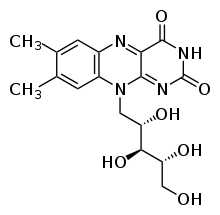Difference between revisions of "Riboflavin in Orange Juice"
| (One intermediate revision by the same user not shown) | |||
| Line 5: | Line 5: | ||
* Vitamin B6 is dependent on FMN (B6 is used in amino acid, glucose, and lipid metabolism) | * Vitamin B6 is dependent on FMN (B6 is used in amino acid, glucose, and lipid metabolism) | ||
| + | [[File:Riboflavin structure.png|400px|thumb|right|Structure of Riboflavin]] | ||
| − | + | Some great food sources are: | |
| − | |||
| − | Some great food | ||
* eggs | * eggs | ||
* green vegetables | * green vegetables | ||
* milk | * milk | ||
| − | Another option to get riboflavin in the diet is orange juice. It only contains 4% of your daily intake, however, it is convenient since it is in the POD of the CSB and in Scots Market. | + | |
| + | Another option to get riboflavin in the diet is orange juice. It only contains 4% of your daily intake, however, it is convenient since it is in the POD of the CSB and in Scots Market. The orange juice is stored in plastic bottles, in a fridge that has a light aimed at the products all day. | ||
| + | |||
| − | |||
does the light pass through the plastic and damage the riboflavin, creating harmful compounds? | does the light pass through the plastic and damage the riboflavin, creating harmful compounds? | ||
Latest revision as of 23:07, 1 February 2018
By Antonetta Axup
Another name for Riboflavin is Vitamin B2, which is can be found naturally in food but also taken as a supplement. In the human body, riboflavin is a needed in multiple different reactions, usually in the either of its active forms: flavin mononucleotide (FMN) and flavin adenine dinucleotide (FAD). For instance:
- FAD is need in order to Tryptophan into Vitamin B3 (which is then used to lower LDL cholesterol levels)
- Vitamin B6 is dependent on FMN (B6 is used in amino acid, glucose, and lipid metabolism)
Some great food sources are:
- eggs
- green vegetables
- milk
Another option to get riboflavin in the diet is orange juice. It only contains 4% of your daily intake, however, it is convenient since it is in the POD of the CSB and in Scots Market. The orange juice is stored in plastic bottles, in a fridge that has a light aimed at the products all day.
does the light pass through the plastic and damage the riboflavin, creating harmful compounds?
Sources:
